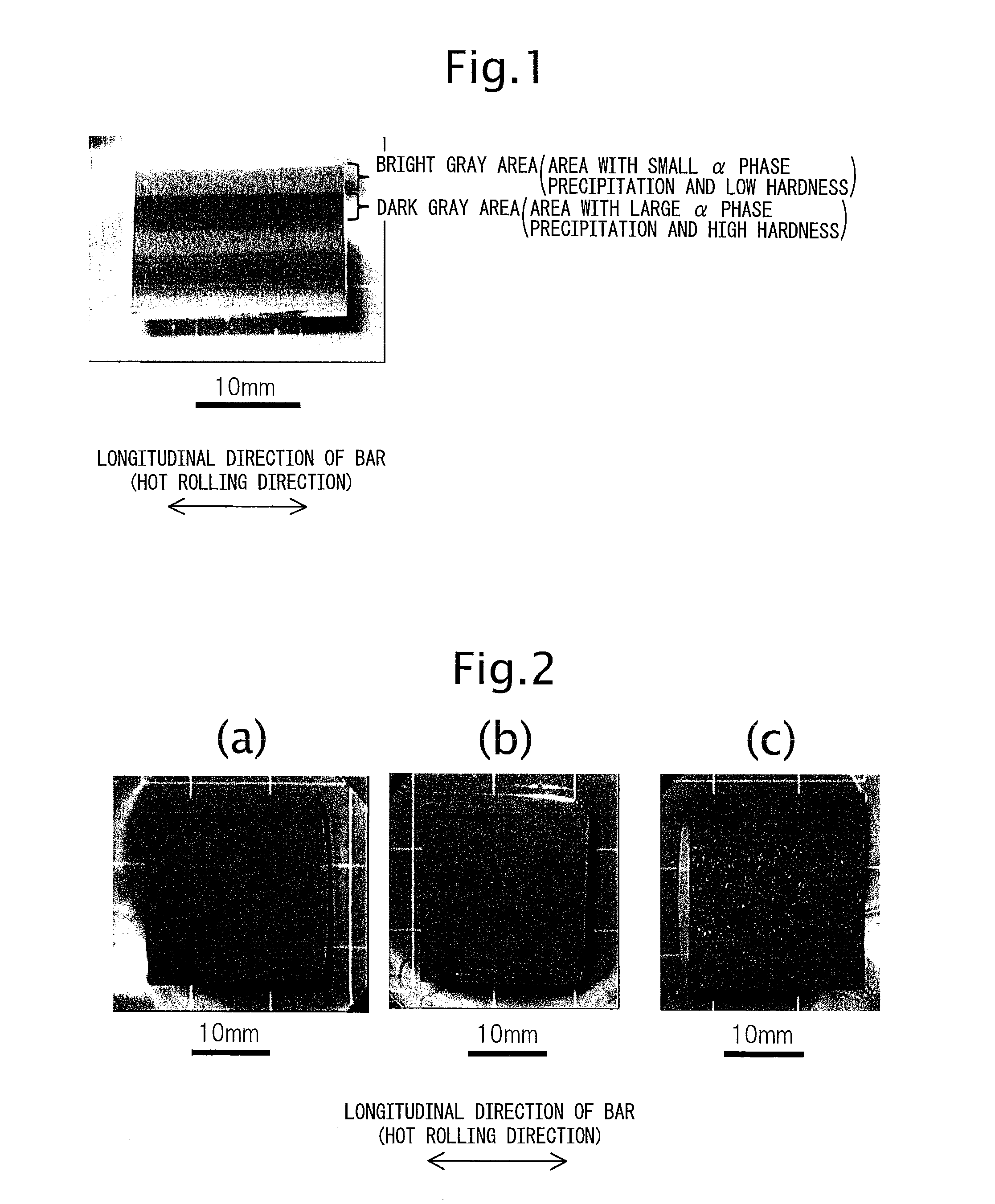Beta-TYPE TITANIUM ALLOY
a titanium alloy and beta-type technology, applied in the field of beta-type titanium alloy, can solve the problems of high possibility of low strength areas forming starting points of fatigue fracture, variations in material properties and aging hardening properties, and insufficient contribution to the base solid-solution strengthening. , the effect of increasing the strength
- Summary
- Abstract
- Description
- Claims
- Application Information
AI Technical Summary
Benefits of technology
Problems solved by technology
Method used
Image
Examples
example 1
[0039](1) to (3) of the present invention will be explained in further detail using the following examples.
[0040]Ingots obtained by vacuum melting were heated at 1100 to 1150° C. and hot forged to prepare intermediate materials which were then heated at 900° C. and hot forged to bars of a diameter of about 15 mm. After this, the bars were solution treated and annealed at 850° C. and air cooled.
[0041]The solution treated and annealed materials were machined into tensile test pieces with parallel parts of a diameter of 6.25 mm and lengths of 32 mm, subjected to tensile tests at room temperature, and measured for tensile strength before aging heat treatment. To evaluate the cold workability, the solution treated and annealed materials were descaled (shot blasted, then dipped in nitric-hydrofluoric acid solution), then lubricated and cold drawn by a die to a cross-sectional reduction of 50% in area. Surface fractures or breakage were checked for by the naked eye between the cold drawing...
example 2
[0048](4) of the present invention will be explained in further detail using the following examples.
[0049]Table 4 shows examples of (4) of the present invention with Zr added. Note that the methods of production, methods of evaluation, etc. were the same as in the above-mentioned [Example 1]. All of the samples of Table 4 had H concentrations of 0.02 mass % or less.
TABLE 4Pre-agingheattreatmentsolutiontreated andResult ofannealedevaluation bymaterialsegregationOxygenColdTensilejudgmentSampleChemical compositions (mass %)Mo + Vequivalent QdrawingstrengthmethodNo.AlFeCrVMoZrON(mass %)formula [1]50% success(MPa)(others)Remarks2-13.12.58.27.5—2.00.1600.008—0.182Good998GoodInv. ex.2-23.02.97.56.3—3.60.1720.007—0.191Good1005GoodInv. ex.2-33.02.27.5—6.51.40.1680.007—0.187Good992GoodInv. ex.2-43.02.35.9—7.22.50.1660.007—0.185Good1002GoodInv. ex.2-53.03.26.32.33.63.20.1650.0065.90.182Good989GoodInv. ex.2-63.02.36.86.42.83.50.1750.0079.20.194Good1016GoodInv. ex.2-73.12.09.02.03.82.00.1710.008...
example 3
[0052](5) of the present invention will be explained in further detail using the following examples.
[0053]Table 5 shows examples of (5) of the present invention with different concentrations of O and N. Note that the methods of production, methods of evaluation, etc. were the same as in the above-mentioned [Example 1]. All of the samples of Table 5 had H concentrations of 0.02 mass % or less.
TABLE 5Pre-agingheattreatmentsolutionCold drawingtreatedPost-Result ofanddrawingevaluationOxygenannealedLimitDrawingreductionbyequivalentmaterialcoldreduction50%segregationQTensiledrawing50% ortensilejudgmentSampleChemical compositions (mass %)Mo + VformulastrengthreductionmorestrengthmethodNo.AlFeCrVMoZrON(mass %)[1](MPa)(%)success(MPa)(others)Remarks3-13.22.27.97.8——0.0900.006—0.107931>80%Good1325GoodComp. ex.of (5)3-2″″″″——0.1590.007—0.178984>80%Good1378GoodInv. ex.3-3″″″″——0.1890.008—0.2111089>80%Good1416GoodInv. ex.3-4″″″″——0.2640.011—0.2941195>80%Good1550GoodInv. ex.3-5″″″″——0.3690.010—0.3...
PUM
| Property | Measurement | Unit |
|---|---|---|
| Young's modulus | aaaaa | aaaaa |
| tensile strength | aaaaa | aaaaa |
| temperature | aaaaa | aaaaa |
Abstract
Description
Claims
Application Information
 Login to View More
Login to View More - R&D
- Intellectual Property
- Life Sciences
- Materials
- Tech Scout
- Unparalleled Data Quality
- Higher Quality Content
- 60% Fewer Hallucinations
Browse by: Latest US Patents, China's latest patents, Technical Efficacy Thesaurus, Application Domain, Technology Topic, Popular Technical Reports.
© 2025 PatSnap. All rights reserved.Legal|Privacy policy|Modern Slavery Act Transparency Statement|Sitemap|About US| Contact US: help@patsnap.com

